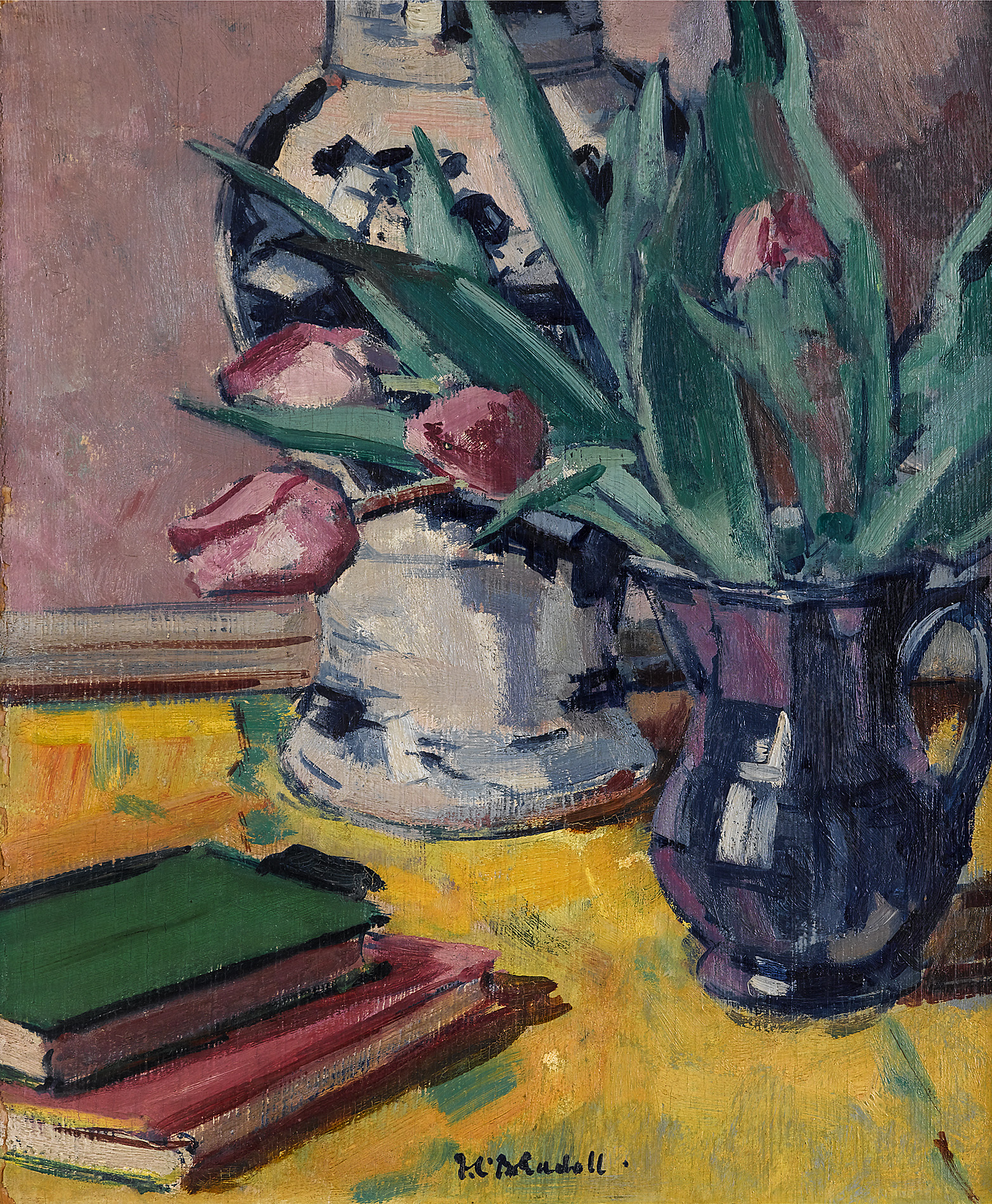FRANCIS CAMPBELL BOILEAU CADELL, R.S.A., R.S.W. (SCOTTISH 1883-1937) ‡
‘TULIPS’
£38,000
Auction: 7 September 2012 at 15:00 BST
Description
signed bottom centre FCB CADELL, and signed and inscribed verso TULIPS/ BY/ F.C.B.CADELL./ 6 AINSLIE PLACE/ EDINBURGH./ ABSORBENT GROUND. NEVER VARNISH./ F.C.B.C., oil on board
Dimensions
45 x 37.5cm (17¾ x 14¾in)
Footnote
Provenance:
Sotheby's, Perthshire 'Animalier Bronzes, Scottish and Sporting Pictures', 29th August 1995, Lot 1009
Exhibited:
Possibly, Royal Glasgow Institute of the Fine Arts, 1919, no. 353.
Note:
In 1920 Cadell made his studio in an exquisite townhouse at 6 Ainslie Place, Edinburgh. Many of his finest interiors and still lifes were painted during this period and, as we shall see, the move marked decided developments away from his pre-war technique. It is rather easy to forget that Cadell was an inter-war era artist. There is a total lack of any residual element of his experiences in the trenches visible in his work. Though he was present at The Somme and spent the considerable majority of his army career serving as a private, no anguish, violence or sadness is tangible in his output whatsoever. This is entirely a result of Cadell's remarkably positive attitude to life, a fact worth mentioning because, quite simply, to understand Cadell's art is to first understand his character.
Cadell has been roundly recorded as an indomitably cheerful and vibrant personality. Always seeing the funny side, ever self-deprecating and immensely charming, his company was always in demand - a fact which was to stand him in good stead when relying on the generosity of patrons in the lean times. Though he was undoubtedly a colourful character, he did not necessarily fit the traditional "artistic eccentric" mould and his love of the good life; of luxury, cleanliness, orderliness and all things beautiful, over-spilled abundantly into his art. Honeyman comments that, to Cadell, "to paint pictures was not enough. One had to express one's idea of decoration in everything. He made his studio a work of art." [1]
Ainslie Place was the studio in question, and the full fruition of this philosophy. The huge windows of the Edinburgh New Town flooded the spacious rooms with light. The floor was a lacquered black, the frames and furniture were gilded and the walls were a distinctive lilac hue. This lilac provides the backdrop of many of Cadell's paintings of this period and is indeed present in the work represented here, 'Tulips' which, stylistically, is likely to date to the late 1920s. The selection of the rather unusual lilac tone is interesting to consider. On the grey end of the spectrum, the tone provides a perfect foil to brighter, more riotous colour; here we see it rendering yellow, blue, pink and green tones perfectly harmonious seemingly against the logic of the un-artistic eye. However, that more sentimental impulses could have influenced the choice of lilac is an attractive supposition. During this period, Cadell was spending regular time on his beloved island of Iona in the Outer Hebrides and was always loathe to return to Edinburgh where he was reminded of his financial realities. It would not be a huge leap to postulate that the lilac reminded him of the heather clad hills he so enjoyed to roam around, and even paid tribute to in a poem in 1913:
No chairs for me when I can lie
And air myself upon the heather
And watch the fat bees buzzing by
And smell the smell of summer weather [2]
Additionally, purple has of course always been a colour of sumptuous overtones, associated with wealth and carrying regal connotations. This would certainly have appealed to Cadell's somewhat decadent sense of style.
Beyond this, 'Tulips' is a quintessential work of this period in many further respects. Cadell was working with wholly confident virtuosity by this stage and had progressed from the looser, suggestive brushwork of his pre-war output to a more robust, solid and vibrant aesthetic. He began working on a chalky white ground to provide his colours with greater purity and impact. He would inscribe emphatically on the reverse of his canvases, as here on 'Tulips', instructing future owners "NEVER" to varnish the surface in order to retain the freshness of tone. However, though he maximised his use of colour, he minimised his handling. In this manner, he was able to cleverly stylize and pare back complicated, even cluttered compositions, producing a clean effect which bordered on the graphic on occasion. This has been credited to Cadell's by now full absorption of the post-Cezanne French School of art. The Scottish Colourists have been praised for returning colour to the palette of Scottish art; however, it is really for their understanding and command of European developments of this period that they deserve the most considerable admiration. Cadell, alongside his fellow Colourists, grasped the use of colour constructively as opposed to simply decoratively. Here we see him use flattened plains of tone to allow his objects to alternatively recede or 'pop'. [3]
This new luxurious colour scheme and artful simplicity, derived from a seemingly effortless minimum of labour, truly encapsulated Cadell and his personal values.
However, at the time, Scotland was a largely artistically staid environment. Cadell's still lifes of this period duly caused a stir in Edinburgh society, condemned by some as "vulgar" and "Bolshevik", [4] and he did not find his new, mature style selling particularly successfully outside his collection of staunch supporters.
[1] p.89, 'The Scottish Colourists: Peploe, Cadell, Hunter', by T. J. Honeyman, London, 1950
[2] p.35, 'Cadell: The Life and Works of a Scottish Colourist,1883-1937', by Tom Hewlett, London, 1988
[3] p.43, 'The Scottish Colourists: Peploe, Cadell, Hunter', by T. J. Honeyman, London, 1950
[4] p.44, 'Cadell: The Life and Works of a Scottish Colourist,1883-1937', by Tom Hewlett, London, 1988

